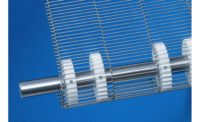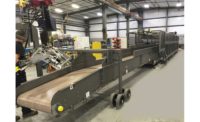In conveyor and belting circles, cleanliness might indeed be next to godliness.
While the equipment is a critical component for enhancing plant operations and the well-being of employees, there also is a dark side: the prospect of also being an origin of pathogens that trigger foodborne illnesses.
That makes it essential for conveyor users to follow stringent cleaning procedures, including targeting the nooks and crevices in apparatus that can hold the debris that generate bacteria.
“Sanitizing all pieces of equipment should be a huge concern for processors,” says Kevin Western, president of Western’s Smokehouse and Meat Market Inc., a Greentop, Mo.-based meat processor. “There is a lot of purge and juice when dealing with fresh foods. The liquids that typically drip from products often end up on the conveyors and not just the belts.”
Yet, belts remain a potentially potent area for pathogens to develop, particularly if the belting consists of interlocking pieces that have spaces for food to lodge. Improvements to apparatus functionality, however, is making it easier to facilitate cleanings.
Easy does it
Ralph’s Packing Co., a Perkins, Okla.-based meat processor, for instance, uses several small conveyors to transport raw beef and pork and packaged products, and its workers are able to more readily access all parts of the equipment for sanitizing after each shift by flipping a lever to release the tension on belts. Cleaning was difficult with previous technology, as operators had to undo bolts with wrenches, says owner Gary Crane.
“It is now easy to wash the top and bottom of the belts without having to take apart the equipment,” he notes. “Before, there was a need to run the belt on the conveyor while washing it. Now we can do a more complete job by moving the belt by hand when cleaning. That is important because we don’t want pathogens hanging around.”
According to Crane, the company has found the continuous rubber belts it uses to be easier to purify than the previous style of belting used, and the company’s cleaning procedure includes foaming the equipment with a cleanser before rinsing it with hot water and applying a sanitizer.
“When it comes to cleaning effectiveness, everything starts with the conveyor design,” says Doug Hankes, vice president of operations for Thrushwood Farms Quality Meats Inc., a meat processor in Galesburg, Ill., and president of the Elizabethtown, Pa.-based American Association of Meat Processors (AAMP). “Hygiene should be the highest priority for processors. Food and employee safety should not take a back seat to any other function.”
To maintain cleanliness, operators need to consistently monitor conveyors and belts to ensure components remain free of food particles and the equipment drains correctly during operations and washings so liquid doesn’t pool in hard-to-reach spots, Hankes says.
Processors, he adds, should work closely with equipment manufacturers to determine the most appropriate conveyor and belting options for their operations. Selecting the optimal apparatus can be daunting as there are wide ranges of choices.
Specific conveyor designs are available, for instance, for handling raw, ready-to-eat and case-ready products, and models also can contain metal detection systems.
Belting alternatives include materials that are made of fabric, metal, metal mesh, plastic, plastic mesh, roller chain, rubber, steel mesh and wire.
“How a belt holds up long term is a critical piece of the puzzle and there are different belts for every application,” Hankes says. “Processors should consider the many product options.”
Also influencing purchasing decisions are the locations within plants in which operators situate conveyors. Machines in wash-down areas, for instance, are likely to receive more frequent doses of water and should have many angles to reduce the prospect of standing liquid, which can harbor pathogens, he says.
A safer haven
The need to focus on sanitation, however, is often a small price to pay for the equipment benefits.
Conveyors, for instance, can reduce the strain on plant personnel by eliminating the need for employees to constantly bend over to lift products exiting packaging machines, Western says.
“Having to bend all day can be hazardous for workers’ health,” he says. “Conveyors that move items directly to the employees [are] an important way to enhance safety.”
Conveyors also have a major impact on worker productivity, adds Chad Lottman, owner of C & C Processing Inc., a Biller, Neb.-based meat processor.
“Adding conveyors to production areas can minimize employee movement by eliminating the need for workers to travel back and forth to access items while performing their tasks,” he says. “It makes their job easier by not requiring constant shifting around.” NP




